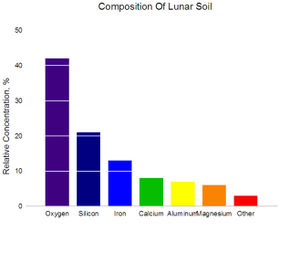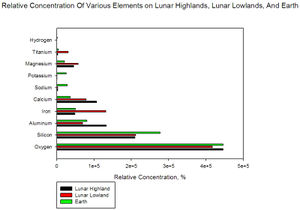Difference between revisions of "Lunar Regolith"
Jarogers2001 (talk | contribs) |
|||
| Line 1: | Line 1: | ||
| − | {{selene | + | {{selene Stub}}<BR/>[[Image:658px-Moon_Comp_Graph.JPG|thumb|Relative Concentration Of Various Elements On The Lunar Surface]] |
| + | [[Image:800px-Moon_VS_Earth_Composition.JPG|thumb|Relative Concentration (in weight ppm) of Various Elements on Lunar Highlands, Lunar Lowlands, and Earth]] | ||
| − | |||
| − | The | + | The layer of debris which blankets most of the moon is commonly refered to as [[exd:Regolith|regolith]]. Billions of years of bombardment from space has created a highly comminuted (this means it has been broken into ever smaller grains and particles) surface through a process sometimes referered to as "impact gardening" or "space weathering." It is estimated that the regolith varies in thickness from 3 to 5 meters over the younger "maria" to approximatly 10 to 20 meters thick in the older "highlands." Below the impact regolith is a layer of "mega-regolith" consisting of highly fractered bedrock that is tens of kilometers thick. |
| + | <BR/><BR/> | ||
| + | The portion of the regolith of a size less than 1cm is generally referred to as [[Lunar Soil]] (which is a misnomer), and the dusty, abrasive portion is referred to as [[Lunar Dust]] or "Fines." | ||
| + | <BR/><BR/> | ||
| + | Lunar regolith is the focus of many proposed methods of [[LUNOX | oxygen production]] and [[In Situ Resource Utilization | in-situ resource utilization]] including: | ||
| + | *[[Ilmenite Reduction]] | ||
| + | *[[Fluorine reaction]] | ||
| + | *[[Glass Reduction]] | ||
| + | *[[Radiation shielding]] | ||
| + | *[[Volatile scavenging]] | ||
| − | == | + | ==Related Articles== |
| − | |||
==External Links== | ==External Links== | ||
*Lunar Soil at Wikipedia.org [http://en.wikipedia.org/wiki/Lunar_soil http://en.wikipedia.org/wiki/Lunar_soil] | *Lunar Soil at Wikipedia.org [http://en.wikipedia.org/wiki/Lunar_soil http://en.wikipedia.org/wiki/Lunar_soil] | ||
| − | + | *PERMANENT.com [http://permanent.com/ http://permanent.com/] | |
| + | *ISRU on the Moon. by Larry Taylor [http://www.lpi.usra.edu/lunar_knowledge/LTaylor.pdf http://www.lpi.usra.edu/lunar_knowledge/LTaylor.pdf] (PDF)<BR/> | ||
[[Category:Selenology]] | [[Category:Selenology]] | ||
| − | + | [[Category:ISRU]] | |
| − | |||
| − | [[Category:ISRU | ||
| − | |||
| − | |||
| − | |||
Revision as of 20:37, 11 May 2008
This article is a Selenological stub. You can help Lunarpedia by expanding it.
|
The layer of debris which blankets most of the moon is commonly refered to as regolith. Billions of years of bombardment from space has created a highly comminuted (this means it has been broken into ever smaller grains and particles) surface through a process sometimes referered to as "impact gardening" or "space weathering." It is estimated that the regolith varies in thickness from 3 to 5 meters over the younger "maria" to approximatly 10 to 20 meters thick in the older "highlands." Below the impact regolith is a layer of "mega-regolith" consisting of highly fractered bedrock that is tens of kilometers thick.
The portion of the regolith of a size less than 1cm is generally referred to as Lunar Soil (which is a misnomer), and the dusty, abrasive portion is referred to as Lunar Dust or "Fines."
Lunar regolith is the focus of many proposed methods of oxygen production and in-situ resource utilization including:
Related Articles
External Links
- Lunar Soil at Wikipedia.org http://en.wikipedia.org/wiki/Lunar_soil
- PERMANENT.com http://permanent.com/
- ISRU on the Moon. by Larry Taylor http://www.lpi.usra.edu/lunar_knowledge/LTaylor.pdf (PDF)








